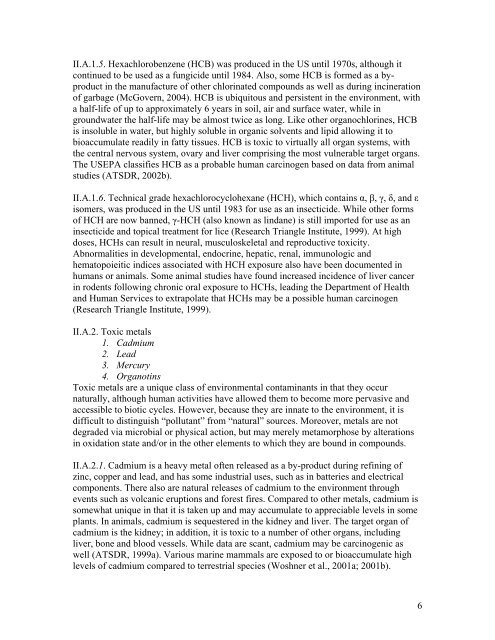Volume III, Appendices EM - National Marine Fisheries Service ...
Volume III, Appendices EM - National Marine Fisheries Service ...
Volume III, Appendices EM - National Marine Fisheries Service ...
You also want an ePaper? Increase the reach of your titles
YUMPU automatically turns print PDFs into web optimized ePapers that Google loves.
II.A.1.5. Hexachlorobenzene (HCB) was produced in the US until 1970s, although it<br />
continued to be used as a fungicide until 1984. Also, some HCB is formed as a byproduct<br />
in the manufacture of other chlorinated compounds as well as during incineration<br />
of garbage (McGovern, 2004). HCB is ubiquitous and persistent in the environment, with<br />
a half-life of up to approximately 6 years in soil, air and surface water, while in<br />
groundwater the half-life may be almost twice as long. Like other organochlorines, HCB<br />
is insoluble in water, but highly soluble in organic solvents and lipid allowing it to<br />
bioaccumulate readily in fatty tissues. HCB is toxic to virtually all organ systems, with<br />
the central nervous system, ovary and liver comprising the most vulnerable target organs.<br />
The USEPA classifies HCB as a probable human carcinogen based on data from animal<br />
studies (ATSDR, 2002b).<br />
II.A.1.6. Technical grade hexachlorocyclohexane (HCH), which contains α, β, γ, δ, and ε<br />
isomers, was produced in the US until 1983 for use as an insecticide. While other forms<br />
of HCH are now banned, γ-HCH (also known as lindane) is still imported for use as an<br />
insecticide and topical treatment for lice (Research Triangle Institute, 1999). At high<br />
doses, HCHs can result in neural, musculoskeletal and reproductive toxicity.<br />
Abnormalities in developmental, endocrine, hepatic, renal, immunologic and<br />
hematopoieitic indices associated with HCH exposure also have been documented in<br />
humans or animals. Some animal studies have found increased incidence of liver cancer<br />
in rodents following chronic oral exposure to HCHs, leading the Department of Health<br />
and Human <strong>Service</strong>s to extrapolate that HCHs may be a possible human carcinogen<br />
(Research Triangle Institute, 1999).<br />
II.A.2. Toxic metals<br />
1. Cadmium<br />
2. Lead<br />
3. Mercury<br />
4. Organotins<br />
Toxic metals are a unique class of environmental contaminants in that they occur<br />
naturally, although human activities have allowed them to become more pervasive and<br />
accessible to biotic cycles. However, because they are innate to the environment, it is<br />
difficult to distinguish “pollutant” from “natural” sources. Moreover, metals are not<br />
degraded via microbial or physical action, but may merely metamorphose by alterations<br />
in oxidation state and/or in the other elements to which they are bound in compounds.<br />
II.A.2.1. Cadmium is a heavy metal often released as a by-product during refining of<br />
zinc, copper and lead, and has some industrial uses, such as in batteries and electrical<br />
components. There also are natural releases of cadmium to the environment through<br />
events such as volcanic eruptions and forest fires. Compared to other metals, cadmium is<br />
somewhat unique in that it is taken up and may accumulate to appreciable levels in some<br />
plants. In animals, cadmium is sequestered in the kidney and liver. The target organ of<br />
cadmium is the kidney; in addition, it is toxic to a number of other organs, including<br />
liver, bone and blood vessels. While data are scant, cadmium may be carcinogenic as<br />
well (ATSDR, 1999a). Various marine mammals are exposed to or bioaccumulate high<br />
levels of cadmium compared to terrestrial species (Woshner et al., 2001a; 2001b).<br />
6
















